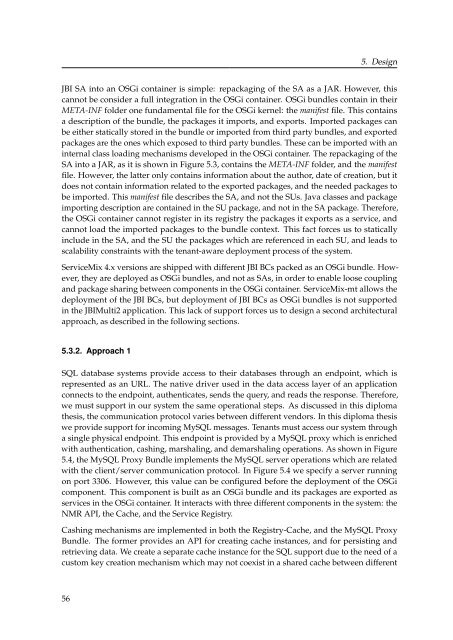Diploma Thesis Santiago Gómez Sáez - IAAS
Diploma Thesis Santiago Gómez Sáez - IAAS
Diploma Thesis Santiago Gómez Sáez - IAAS
You also want an ePaper? Increase the reach of your titles
YUMPU automatically turns print PDFs into web optimized ePapers that Google loves.
5. Design<br />
JBI SA into an OSGi container is simple: repackaging of the SA as a JAR. However, this<br />
cannot be consider a full integration in the OSGi container. OSGi bundles contain in their<br />
META-INF folder one fundamental file for the OSGi kernel: the manifest file. This contains<br />
a description of the bundle, the packages it imports, and exports. Imported packages can<br />
be either statically stored in the bundle or imported from third party bundles, and exported<br />
packages are the ones which exposed to third party bundles. These can be imported with an<br />
internal class loading mechanisms developed in the OSGi container. The repackaging of the<br />
SA into a JAR, as it is shown in Figure 5.3, contains the META-INF folder, and the manifest<br />
file. However, the latter only contains information about the author, date of creation, but it<br />
does not contain information related to the exported packages, and the needed packages to<br />
be imported. This manifest file describes the SA, and not the SUs. Java classes and package<br />
importing description are contained in the SU package, and not in the SA package. Therefore,<br />
the OSGi container cannot register in its registry the packages it exports as a service, and<br />
cannot load the imported packages to the bundle context. This fact forces us to statically<br />
include in the SA, and the SU the packages which are referenced in each SU, and leads to<br />
scalability constraints with the tenant-aware deployment process of the system.<br />
ServiceMix 4.x versions are shipped with different JBI BCs packed as an OSGi bundle. However,<br />
they are deployed as OSGi bundles, and not as SAs, in order to enable loose coupling<br />
and package sharing between components in the OSGi container. ServiceMix-mt allows the<br />
deployment of the JBI BCs, but deployment of JBI BCs as OSGi bundles is not supported<br />
in the JBIMulti2 application. This lack of support forces us to design a second architectural<br />
approach, as described in the following sections.<br />
5.3.2. Approach 1<br />
SQL database systems provide access to their databases through an endpoint, which is<br />
represented as an URL. The native driver used in the data access layer of an application<br />
connects to the endpoint, authenticates, sends the query, and reads the response. Therefore,<br />
we must support in our system the same operational steps. As discussed in this diploma<br />
thesis, the communication protocol varies between different vendors. In this diploma thesis<br />
we provide support for incoming MySQL messages. Tenants must access our system through<br />
a single physical endpoint. This endpoint is provided by a MySQL proxy which is enriched<br />
with authentication, cashing, marshaling, and demarshaling operations. As shown in Figure<br />
5.4, the MySQL Proxy Bundle implements the MySQL server operations which are related<br />
with the client/server communication protocol. In Figure 5.4 we specify a server running<br />
on port 3306. However, this value can be configured before the deployment of the OSGi<br />
component. This component is built as an OSGi bundle and its packages are exported as<br />
services in the OSGi container. It interacts with three different components in the system: the<br />
NMR API, the Cache, and the Service Registry.<br />
Cashing mechanisms are implemented in both the Registry-Cache, and the MySQL Proxy<br />
Bundle. The former provides an API for creating cache instances, and for persisting and<br />
retrieving data. We create a separate cache instance for the SQL support due to the need of a<br />
custom key creation mechanism which may not coexist in a shared cache between different<br />
56

















